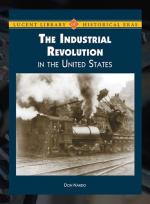|
This section contains 249 words (approx. 1 page at 300 words per page) |

|
An Examination of British Success in the Industrial Revolution
Summary: Examines the factors leading to British Success in the Industrial Revolution. Focuses on the nation's supply of natural resource and development of fast, cheap methods of transporting goods.
Britain had large supplies of coal & iron. Iron, used for machines and steam engines, used coal for fuel. Abraham Darby found that coal damaged the iron. He produced cheap, better iron. His grandson made the first cat iron bridge. From thereon, iron had better uses.
Textiles were Britain's largest industry. Indian cloth was very popular and used a slow process called the putting out system. The fly shuttle had fast weavers and the spinning jenny spun many threads at the same time. Arkwright's water frame used water for speed in order to spin.
Fast, cheap methods were needed for moving goods. Turnpikes were privately built roads which charged fees to travelers. The steam locomotive made railroads possible by pulling carriages along rails. Scots made paddle wheel steamboats for pulling barges Steamships for ocean voyages were hard to design & by the late 1880s freighters carried more cargo.
Machines were...
|
This section contains 249 words (approx. 1 page at 300 words per page) |

|


